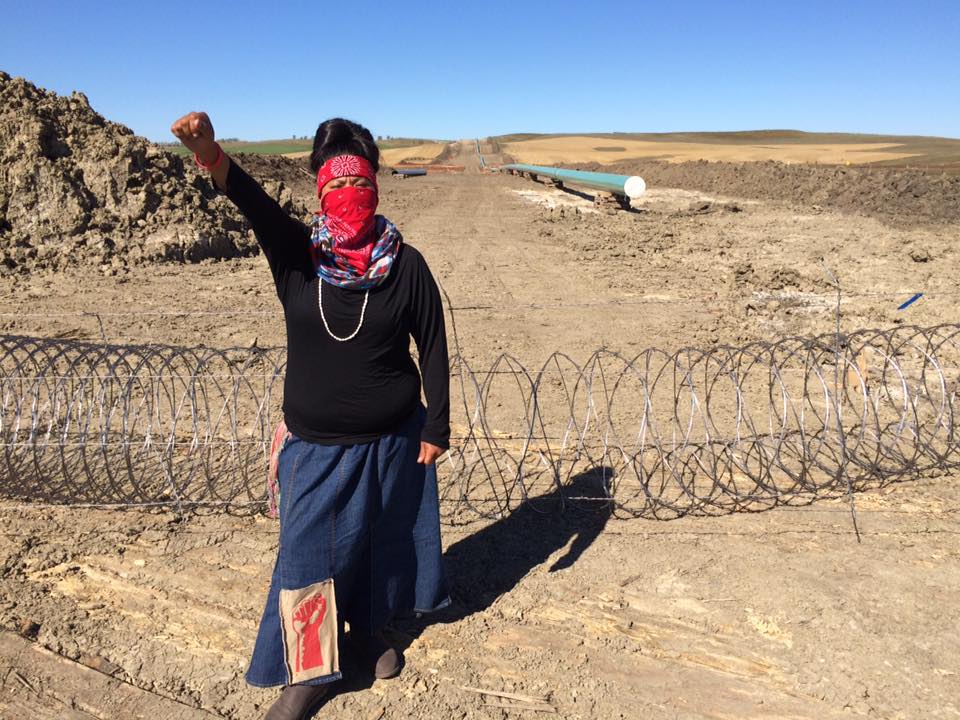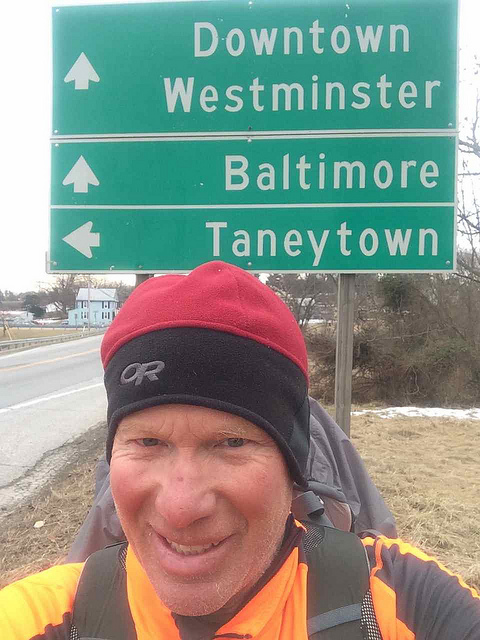Builders of the Dakota Access Pipeline are making final preparations to drill under the Missouri River near the Standing Rock Reservation despite not having the final permits needed to proceed. Energy Transfer Partners, the company building the pipeline, has indicated they plan to drill under the Missouri within two weeks. They plan to finish the last segment at the river although the Army Corps of Engineers has not granted an easement to drill under Lake Oahe.
Thousands of indigenous people and allies have been holding firm in the standoff against hundreds of militarized police near the Reservation. In what has become the largest resistance involving indigenous rights since Wounded Knee, Water Protectors are standing up against the energy company determined to complete the oil pipeline near Cannon Ball, North Dakota.
The uprising near Lake Oahe on the Missouri River has drawn a brutal application of police force and is likely to shape the character of fossil fuel project fights for years to come. Hundreds have already been arrested, along with several key members of the press.
The Sioux have demanded that pipeline construction not cross the Missouri at Lake Oahe, which would risk contaminating their water supply. They also object to construction crews destroying their sacred ancestral burial sites.
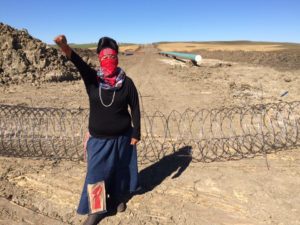
Police from five nearby states have joined the Morton County local police force, carrying assault weapons, chemical agents, and flashbang grenades, and equipped with LRADs, helicopters, surveillance aircraft, and military grade assault vehicles. The Water Protectors of Standing Rock include over 300 tribes from 90 Red Nations and have encamped at four locations close to the pipeline path.
Tribe Elders have requested Water Protectors to remain nonviolent, but tension has sparked clashes. Water Protectors continue challenging authority by inserting themselves in the face of overwhelming police force. They filed for a temporary court injunction, but when that failed, they erected road barricades, forced work stoppages by chaining themselves to equipment, and blocked crews from accessing project sites to stop pipeline construction.
The FCC has declared a four-mile no-fly zone over area where police and Water Protectors are staged, prohibiting media from using drones equipped with cameras to capture confrontations. But independent media has nevertheless been able to report key events.
Dakota Access LLC, the corporation building the Dakota Access pipeline, is intent on completing the $3.8 billion project by year’s end despite a tsunami of mounting opposition, both grassroots and political. If completed, the project will send 470,000 barrels of Bakken crude from North Dakota to Illinois for refining.
Energy Transfer Partners Criticized by Its Own Industry Publication
A high profile energy trade publication, American Energy News, which typically reports on the side of the gas and oil industry, came out with uncharacteristic criticism of the project, describing it as a liability for the reputation of and a “political disaster” for the American gas and oil industry. Energy Transfer Partners, it said, had “a lot of soul searching to do” with regard to their handling of the project.
“Energy Transfer Partners and the Petroleum Institute have just made a huge strategic mistake with their handling of the Dakota Access pipeline protests,” it said.
Violent Police Tactics
The standoff has become a spectacle of state-sponsored violence against indigenous people. Standing Rock Sioux have reported trauma from police during arrests and processing, including many injuries, strip searches, and include a horse that was shot and killed by police. Images of Water Protectors with wounds from rubber bullets are being circulated on social media.

Democracy Now reporter Amy Goodman was charged last month with inciting a riot, although she was only equipped with a microphone, camera, and crew. The charges were later dismissed by a judge.
A dog attack on September 3, unleashed by a security firm hired to guard the pipeline, resulted in six injuries, including a child and a pregnant women, was but a forewarning of what was yet to come.
Erin Schroeder, an independent journalist, was shot by police with what is believed to be a rubber bullet while she interviewed an activist Cantapeta Creek. Her camera caught the moment of her shooting and reaction as she fell to the ground. A photo of her back showed a grapefruit sized welt on her upper left back. Police denied they shot her but they were recorded carrying and pointing weapons, grenade launchers, and firing teargas at the Water Protectors.
Both sides of the standoff are deeply entrenched, refusing to concede ground in the 1,168-mile project. Sioux Elders have accused the police of being used as a corporate styled security force to enforce its agenda.
Police military tactics have solidified tribe alliances in a nearly unbreakable bond of solidarity not seen in many decades. Indigenous tribes joined at the camps now number over 300; elders and youth standing shoulder to shoulder against four-man-deep lines of militarized police. Internal fissures of between tribes from long ago have been forgotten. The Seven Council Fires, an alliance which has not been invoked in many generations, has also been rekindled.
Water Protectors have grown emboldened too, defiantly erecting barricades on highway 1806, a road near the camps, and setting them on fire, a tactic sometimes seen in politically tattered developing counties where unrest commonly pits governments and police against citizenry. Cat-and-mouse resistance tactics have been effectively delaying completion of the pipeline. They have been well-supported by copious donations of money and supplies from loyal social media followers.
The United Nations has weighed in on the uprising as well, calling for a halt to construction and condemning police tactics, further tarnishing the industry.
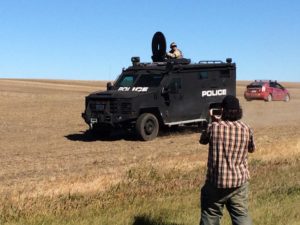
The UN requested the U.S. government to comply with its commitment to the Rights of Indigenous Peoples. “We call on the government of the United States to…ensure the right of the Sioux to participate in decision-making, considering that the construction of this pipeline will affect their rights, lives and territory,” said Alvaro Pop Ac, Chair of the Permanent Forum on Indigenous Issues.
The governor of North Dakota activated the National Guard and condemned the Water Protectors for endangering public safety, but there are no residents in the remote area around the camps or adjacent to the pipeline path at the Standing Rock Reservation.
Timeline of Significant Events
July 25, 2016: The Army Corps of Engineers issued a finding of no significant impact on the environment.
July through September: Standing Rock Sioux assemble “Spirit” and “Red Warrior” camps near Lake Oahe not far from the Standing Rock reservation.
August 13: Water Protectors surged onto the pipeline construction site. Morgan County police arrested 18, including Sioux elder Dave Archenbault II.
August 24: Tribes packed U.S. District Court in Washington, DC. Judge James E. Boasburg issued a temporary injunction until he could consider a ruling which he planned to issue in a week.
September 3: A security company hired by Dakota Access released dogs on hundreds of Water Protectors, injuring six. Reporter Amy Goodman of Democracy Now, who was filing a news segment at the time and released a viral video report of the attack showing Water Protectors being bitten and dogs bloodied from biting them.
September 9: North Dakota State’s Attorney Ladd Erickson issued an arrest warrant for Amy Goodman for misdemeanor criminal trespass; later dropped that charge, but filed a felony warrant for inciting a riot. Press freedom groups decried the prosecutor’s act as a blatant infringement of press freedom and a trampling of First Amendment rights.
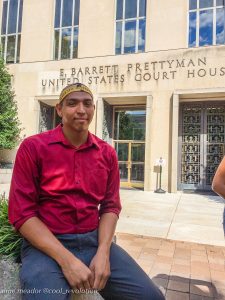
September 9: Judge James E. Boasberg ruled pipeline construction could proceed. Minutes following his ruling, the Obama Administration requested Dakota Access to voluntarily stop construction. In a joint published statement, the Army Corps of Engineers, State Department, and Department of Interior, wrote, “We request that the pipeline company voluntarily pause all construction activity within 20 miles east or west of Lake Oahe.” However, construction continued.
October 17: Charges against Amy Goodman were dropped. Goodman heralded the decision, calling it “a great vindication of the First Amendment and of our right to report.”
October 22: Water Protectors established Oceti Sakowin Treaty Camp, a front line encampment directly in the path of the pipeline and declare they have re-occupied the land under eminent domain. In 1851, the land had been affirmed as under domain of the Oceti Sakowin in the Fort Laramie treaty. Police respond in full battle gear, deploy mace, and arrest 83 people.
October 23: Water Protectors returned and took back the same land where arrests occurred the previous day. They re-established camp Oceti Sakowin, setting up several tipis and structures, erected two barricades on highway 1806 and confronted police. Police lined up with humvees, MRAPs and body armor.
Week of October 23: More than a million people “signed in” at the Sacred Stone and Oceti Sakowin camps on Facebook. The online sign-in’s purpose was to throw off known police tracking tactics.
October 28: Water Protectors clashed with police in a major escalation resulting in 141 arrests. During the confrontation, protectors claim police fired tasers and rubber bullets. An LRAD was turned on the Water Protectors and recorded on video at the scene. Police sprayed chemical agents into Water Protector’s faces. Police wrote numbers on arms of those arrested with indelible ink and confined them in what Water Protectors claim were dog kennel cages, further inflaming anger at the camps.
November 2: Police engaged Water Protectors again at the edge of Cantapeta Creek at Turtle Mountain, a known burial site, north of Cannon Ball Run. Protectors were trying to access the mountain as the pipeline buildout approached Lake Oahe. Protectors had built a wooden foot bridge over the creek to access the sacred land from the reservation side. Police fire rubber bullets and mace protectors as they stand in the water near the creek edge.
Also on November 2 at Cantapeta Creek, journalist Erin Schroeder was shot in the back with a rubber bullet while interviewing a Water Protector. Her camera captured video of the moment she was shot. A photo taken of her back injury was widely shared.
November 3: The UN sent a team to investigate indigenous people’s claims of human rights abuses of Water Protectors by North Dakota police. “When you look at what the international standards are for the treatment of people, and you are in a place like the United States, it’s really astounding to hear some of this testimony,” Robert Borrero of the International Indian Treaty Council told Reuters.
Standoff Continues
The Obama Administration is presently considering a reroute of the pipeline away from the planned pipeline tunnel under Lake Oahe near the Standing Rock Reservation. Obama spoke on November 2, saying the Army Corps of Engineers is considering a reroute because of the unrest.
But Elders say the project route has already destroyed burial sites and whatever river crossing is chosen, it will still cross the Missouri upstream, potentially affecting the reservation and millions dependent on the river.
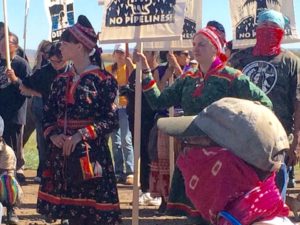
Indigenous burial sites have already been plowed under by construction crews despite efforts to protect them, and over 400 have been arrested. Many have suffered injuries from rubber bullets and strong-armed police tactics.
The Standing Rock Sioux Elders have reinforced a peaceful ethic among all the water protectors. It is possible there would by now have been fatalities in the tense standoff if Water Protectors had taken more militant measures.
The Standing Rock Sioux have vowed to remain by Lake Oahe through the harsh North Dakota winter or until the pipeline is permanently stopped.
Even with a reroute and possible completion of the pipeline, suspicion and resentment over the character of the build-at-any-cost project runs deep and has cast what will be long lasting bitter memories for those who took part in the uprising against the Dakota Access pipeline.
It has also marked the beginning of a new epic of aggressive environmentalism in the U.S. It is also the new face of a environmental movement defaulting to resistance which from now on, the delegitimized fossil energy industry will have to contend with.

